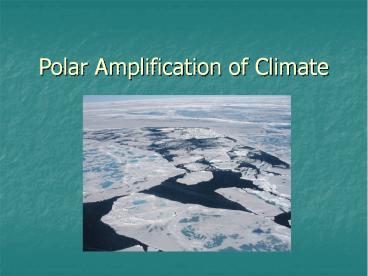Polar Amplification of Climate - PowerPoint PPT Presentation
Title:
Polar Amplification of Climate
Description:
Polar Amplification of Climate Polar Amplification of Climate Change in Coupled Models Holland, M. M., Bitz, C. M. Climate Dynamics, Vol. 21, Issue 3-4, pp.221-232 ... – PowerPoint PPT presentation
Number of Views:92
Avg rating:3.0/5.0
Title: Polar Amplification of Climate
1
Polar Amplification of Climate
2
Polar Amplification of Climate Change in Coupled
ModelsHolland, M. M., Bitz, C. M. Climate
Dynamics, Vol. 21, Issue 3-4, pp.221-232, Sept
2003.
- Analysis of northern hemisphere polar
amplification of climate by means of comparison
amongst a group of climate models - Surface warming in the arctic
- Magnitude
- Distribution
- Seasonality
3
(No Transcript)
4
Sea-ice physics for models with high polar
amplification
5
Whats going on with BRMC?
6
Variables
- Sea ice
- Extent
- Thickness
- Snow coverage on land
- Cloud coverage
- Ocean heat transport
7
Sea Ice Extent
- Ice extent and latitude of maximum warming are
significantly correlated, R-.80 - Models with larger ice extents have a tendency to
have maximum warming at lower latitudes, why is
this?
8
Sea Ice Extent
- Larger ice extents generally cause higher global
sensitivity because the earth has more available
ice to melt (only for models with low-moderate
polar amplification) why not high amplification
models? - No significant correlation between ice extent and
normalized warming, considering all models
together
9
Sea Ice Thickness
- More highly correlated to normalized warming than
sea ice extent, R-.40
10
Sea Ice Thickness
- Suggests that because thin ice is more easily
melted, warming causes greater loss of ice extent - Greater albedo feedback and loss of insulation
between ocean and atmosphere amplify the warming - Still, weak correlations suggest some other
factors may be at work...
11
Snow Coverage on Land
- No significant correlation between snow coverage
and normalized warming, considering all models
together - However, as with ice extent, a significant
correlation exists among the models with
low-moderate polar amplification, R.67
12
Snow Coverage
- Correlation (among low-moderate amplification
models) is probably a result of the snow coverage
on land being highly correlated to the extent of
ice, and not indicative of the snow extent
influencing the polar amplification of warming
13
Cloud coverage
- Does increased cloud coverage have a positive or
negative effect on polar amplification of
warming?
14
Cloud Coverage Temperature Feedbacks
High Clouds
Low Clouds
15
Summer Clouds
- Changes in ice-albedo, and thus absorbed solar
radiation, did not result in changes in cloud
cover during summer - However, the high amplification models do have a
tendency to have increased summer cloud cover
16
Winter Clouds
- Also, decreased winter cloud cover in control
climate is correlated to higher polar
amplification, R-.50 - Problem model bias? Control climate cloud
conditions related to change in clouds, R-.76,
Lower levels of original cloud cover allow for
greater change - Larger winter cloud cover changes correlated to
higher amplification, R.74,
17
Cloud Coverage
- Problems
- No distinction between high and low clouds
- Dont know enough about cloud relationships and
feedbacks - Dont have data from all of the models
18
Ocean Heat Transport
19
ECH-3
CCSM
CERF
CCSR
MRI
BMRC
CCC
GFDL-A
GISS
20
CCSM
ECH-3
CERF
CCC
CCSR
BMRC
GISS
MRI
GFDL-A
21
Ocean Heat Transport
- Control climate ocean heat transport and change
in transport are both significantly correlated to
polar warming
22
Ocean Heat Transport
- Because increased heat transport by the ocean is
correlated with both sea ice extent and
thickness, it seems possible that this then
decreases surface albedo by melting sea ice and
amplifies warming
23
Conclusion
- Possible factors affecting increased polar
amplification based on these models - Thin sea-ice cover
- Increased ocean heat transport to poles
- Increase in winter cloud cover
24
Conclusion
- Further work is needed within single models to
clarify and better understand the relationships
suggested by this group of models - From this study it is clear that very accurate
depictions of current sea ice characteristics,
such as extent and thickness, are necessary to
receive valid data concerning the arctic
responses to increased warming by greenhouse gases
25
Arctic pictures
26
(No Transcript)
27
(No Transcript)
28
(No Transcript)
29
(No Transcript)
30
(No Transcript)
31
(No Transcript)
32
(No Transcript)































